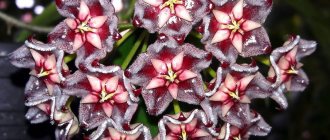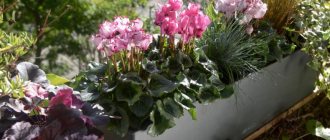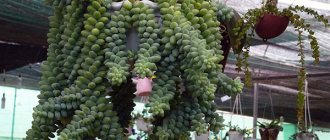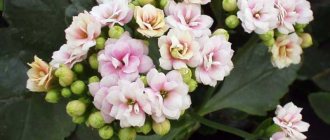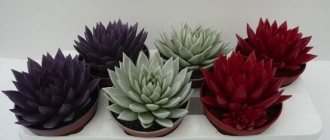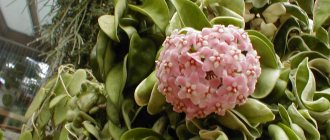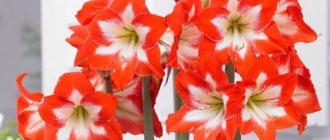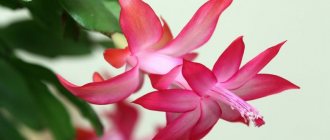Author: Elena N. https://floristics.info/ru/index.php?option=com_contact&view=contact&id=19 Category: Houseplants Published: January 20, 2019Last edits: October 16, 2021
- Growing from seeds
- Insect pests
- Fleshy Hoya (Hoya carnosa), or waxy Hoya
plant (lat. Hoya) , or, as we call it, wax ivy , belongs to the genus of evergreen shrubs and vines of the subfamily Lastovnevye, family Kutrovye. More than two hundred species of hoya grow in the tropics of South and Southeast Asia, Polynesia and the west coast of Australia. Hoya liana prefers open forests, in which it finds a tree for support, or rocky slopes. The Hoya flower was named by the famous Scottish scientist Brown, the author of the theory of “Brownian movement”, in honor of his fellow English gardener Thomas Hoy, who devoted his life to growing tropical plants in the greenhouses of the Duke of Northumberland.
Description
The beautiful liana is a shrub with elastic and fleshy shoots that can grow up to 10 meters in length. At home, the length does not exceed 5 meters.
First of all, the smooth top with purple skin grows. Subsequently, it becomes green and leaves grow on it. At normal humidity, aerial roots form in the nodules. Over time, the stem hardens.
Leaves grow along the entire length of the shoots. Young leaves are soft and shiny. Later, the shine disappears, and the leaves become elastic and matte in structure. The leaf length varies from 5-8 cm, and the width - from 3-5 cm.
The plant is characterized by wave flowering. It begins in June and continues until autumn. Each whisk can last up to 21 days. Inflorescences appear on characteristic branches. Flowers are collected in oval umbrellas. The corolla includes a small crown framed by five petals.
Each bud resembles a white, pink or cream star. The crown is often very different in color saturation from the petals. In the presented photo of Hoya you can enjoy the beauty of the bush.
The pleasant and thick aroma of ivy flowers is designed to attract insects. Flowers produce large amounts of nectar. It is important to know that after flowering it is not advisable to remove the sprout, otherwise it will grow and produce new buds, according to the description of the flower.
Varieties of wax ivy
The Hoya genus includes more than 50 varieties, and in order not to get confused in the diversity, we will highlight the most popular varieties of indoor flowers.
Hoya bella (beautiful, beautiful) is an evergreen flower, the vine-stems of which reach a length of 50 cm. The plant has small white flowers resembling five-pointed stars, with a crimson center, and collected in inflorescences of 7-10 pieces. In favorable weather, drops of fragrant nectar can be seen in the center of the flowers. Hoya bella is native to Southern China and Indonesia. Blooms from May to September.
Hoya kerri (kerry) was discovered in Thailand in 1911 by US professor A. Kerry. Currently, this species is also found in Laos, South China and on the island. Java. The flower gained popularity thanks to its heart-shaped leaves. On the eve of Valentine's Day, it is in demand in flower shops and is a welcome gift on February 14th. Thanks to this, Hoya kerry has a second name among the people - Hoya Valentine.
The leaves of this species are fleshy, leathery and large (up to 15 cm). The flowers are small and come in different shades: lemon, white-yellow and pink; collected in inflorescences-umbrellas of 15-20 pieces. The nectar released from the flowers is dark in color and tends to stain the petals, changing their color from pink to red-brown. The color of the petals also depends on the lighting - the more light, the richer the color. Unlike representatives of the species, Hoya kerry cannot boast of rapid growth.
Caring for a flower at home is quite simple, and Kerry will respond positively if you provide it with:
- light and warmth;
- timely watering without waterlogging;
- spraying in hot weather;
- minimal watering in winter.
Hoya imperialis (imperial, majestic) was discovered in 1846 in the Philippine Islands.
This indoor flower with fleshy, pubescent shoots (up to 8 meters long) has smooth oval leaves (up to 20 cm) with sharp tips. Hoya flowers are dark red inside, with a white crown, and greenish-yellow outside, collected in inflorescences of 6-10 pieces. The diameter of the flowers reaches 6 cm and is considered the largest among the representatives of the species. Imperialis blooms for two weeks. In the evening and at night, nectar is released abundantly, and the aroma becomes most vibrant. Hoya imperialis has subspecies that differ in flower color:
- Alba - white flowers with a green tint;
- Palvan - yellow flowers with a red tint;
- Borneo Red - purple flowers;
- Raushii - white-green flowers with pink splashes, wavy leaves.
Under good conditions it grows strongly and requires a lot of space and support. Loves moist (but not waterlogged) soil and spraying with warm water. Does not tolerate temperature drops down to 20°C, but bright sunshine is unacceptable, as it can lead to leaf burns. In winter, the plant needs to be illuminated. In order for Hoya majestic to grow better, it needs to be pruned periodically, but do not be afraid of the copious secretion of juice.
Hoya australis (Australian, southern) is native to Indonesia, Polynesia and Australia. It was discovered by botanists J. Banks and K. Solender in 1770, during James Cook's expedition to the shores of Australia.
Currently, breeders have developed a large number of cultural hybrids of Australian Hoya, the most famous of which is “Lisa”. Hoya australis lives up to 10 years and during this time the vine grows greatly, requiring support. Khoya branches are covered with dense, shiny, oval-shaped and crimson-colored foliage. Umbrella inflorescences look charming and can bear up to 40 flowers. The flower stars, no more than 2 cm in diameter, are white with a pink center. Hoya will delight you with the first flowers after planting in the second or third year and will produce flower stalks twice a year - from June to November. Unlike Hoya imperial, the Australian hoya does not tolerate pruning well, so you should limit yourself to only removing diseased and dried leaves. It is not demanding on lighting and can grow in both light and partial shade. But winter light is not enough for active growth and flowering. Hoya australis needs moderate watering, frequent and careful spraying in the summer (so that water does not get on the flowers), and in winter it can be watered once every week and a half. Subspecies of Hoya australis:
- Trail - has the smallest flowers;
- Forester et Liddle - cream-colored flowers;
- Bailey Hill - round yellowish leaves, white-cream flowers, with red spots. The lower threshold of comfortable temperature for growth and development is 21 ° C;
- Tonga - the largest flowers among the representatives of the species;
- Paxtoni and Paxtoni Variegata - has variegated elongated leaves.
Hoya longifolia (longleaf) was found in Thailand in 1834. Khoya differs from other representatives of the genus in its elongated paired leaves. The flowers are white and pink, collected in inflorescences of 15-20 pieces. The time for flowering begins in May. The shape of the leaves is not the only difference between Hoya longifolia. This is the most cold-resistant species, withstanding a decrease in temperature in winter to 10°C. Positively relates to bright sun and high humidity.
Hoya lacunosa (lacunosa) has diamond-shaped leaves with an uneven surface and a depression in the middle, for which it received its second name - concave. It blooms in May (only five days), with white and cream flowers forming spherical inflorescences of 15-20 pieces. When exposed to the sun, the leaves “tan” and become bronze. But you should not expose it to bright sun if the air humidity is low. Lacunosa is undemanding and easy to care for, so it is recommended for beginning gardeners.
Hoya multiflora (many-flowered) was discovered in 1826 by the botanist Blume.
Multiflora has wavy leaves up to 12 cm long. It blooms in the 11th month after planting with white-yellow flowers collected in inflorescences of 15-20 pieces. Reacts painfully to a drop in temperature to 20 °C (it can drop flowers and leaves). Demanding on soil and air moisture. Popular subspecies:
- Speckles – leaves are spotted and flowers are cream-colored;
- Shooting Star - flower petals resemble the tail of a comet;
- Variegata (rare species) – leaf edges are white.
Hoya carnosa is very common and has more than 100 subspecies. The liana reaches a length of 6 meters. The leaves are oval, fleshy and large. The flowers are small (up to a centimeter in diameter) and dense, up to 24 pieces in an inflorescence. The color ranges from pale pink to purple. The plant is unpretentious and can withstand temperature drops of up to 10°C.
Flower transplant
In flower shops, plants are usually “overfed” with fertilizers and stimulants, therefore, it is advisable to change the soil substrate for ivy. If you took an already used pot for the hoya, then it must be rinsed well and disinfected with a weak solution of potassium permanganate. The substrate for waxy hoya is sold in specialized stores, or you can prepare it yourself from humus, sand, sphagnum moss and perlite. Expanded clay should be poured into the bottom of the pot for drainage.
As the hoya grows, it is transplanted into larger pots, but not more than once every 2 years.
During replanting, it is not a bad idea to do “formative” pruning of very long shoots, because flower stalks appear on shorter shoots.
Correct lighting
Hoya is a tropical plant, which means it needs good lighting and is ok with direct sunlight. However, it is worth remembering that during hours of maximum sun activity, enhanced by window glass, it is better to shade the ivy, otherwise the plant may get burned. The ideal place to place wax ivy is an east or west window. In the autumn-winter period, the sun is clearly not enough for the vine, and if you want it to please you with flowers and grow as actively as in the summer, you need to take care of illumination with phyto-lamps.
Hoya care at home
Hoya is quite demanding regarding soil moisture and ambient air. It is optimal to keep wax ivy in slightly moist soil and water it as the top layer dries. In addition, in summer it is recommended to spray the leaves, bypassing the flowers. But if, thanks to its leathery leaves, wax ivy can still tolerate some aridity, then it has a very negative attitude towards lower temperatures and the minimum permissible mark when growing hoya is 21 ° C. A decrease in temperature leads to a lack of flowering. In the summer, if the size of the hoya allows it, you can take it outside when it rains; it responds very positively to such a natural shower. When flowering ends, there is no need to cut off the flower stalks; it is on them that the buds will form in the future.
Feeding an indoor flower
Complex mineral fertilizers must be applied in the spring to ensure abundant and long-lasting flowering of ivy. It is advisable to buy special complexes designed for flowering succulent species. If, when replanting, compost or humus is used as a pot filler, then fertilizers may not be used at all.
Landing
To plant the plant, you need to purchase a suitable pot. The crown of the shrub is prone to rapid growth, so it is important to take care of reliable support. The soil can be bought in ready-made briquettes, or you can make your own mixture from:
- Sphagnum moss;
- peat;
- perlite.
Important: in order to enjoy abundant flowering more often, select a tight container.
Care
There are more than 50 subspecies of the plant. But only part of the genus has been cultivated. The most popular varieties among plant growers for home care are the Fleshy and Beautiful Hoya varieties. With effort and love, indoor Hoya flowers will be similar to those that grow in the tropics.
How to get new plants?
Caring for hoya at home includes the propagation procedure. This plant can be propagated by cuttings, seeds and layering.
The first method is the most popular and easiest. For rooting, use a shoot with several leaves. It is cut between the nodes. The process of rooting cuttings is carried out both in water and in a soil mixture of sand and peat. Further care of the cuttings until they take root is to ensure a stable temperature within 20 degrees. After about three weeks, the first roots will appear on the shoots.
The main advantage of propagation using layering is the resulting young plant, which blooms in the year of planting. You need to make an incision on the shoot of the mother ivy, then cover it with moistened moss and tie it with polyethylene. After roots appear on the layering, it is separated from the main flower and planted in the soil. Some gardeners lay the stem on the soil in a nearby planting container, cover it with moss and secure it well. As soon as the shoot takes root, it is carefully cut off from the main flower.
To successfully propagate Hoya at home, it is necessary to use layering or cuttings from adult specimens.
Seed propagation requires a lot of time and great care, so it is almost never used in amateur cultivation, but only for breeding new varieties and hydridization.
Temperature
In the room where the flower grows, the air temperature should be between 20 - 30 degrees. Periodically, the leaves of the evergreen vine plant need to be sprayed with water. The room should be ventilated. In the summer, you can take the flower out into the fresh air - a balcony or terrace.
In the cold season, a flower can be resistant to a temperature drop of 15 degrees, but no more. The optimal indoor temperature in winter is 16-18 degrees. If the bush has been exposed to hypothermia, it will most likely begin to dry out and may soon die.
Lighting
In order for the bush to delight with lush flowering and grow well, you need to choose the ideal place. It should be slightly shaded, it is important to avoid direct sunlight.
Ivy is a hanging plant. Because of this, it can entwine the entire room, becoming a beautiful decoration in the house. Flower growers should avoid keeping shrubs near heating devices during the cold period, as this may cause the plant to dry out.
Evergreen liana needs long-term lighting. Breeders recommend additional lighting of the plant during the flowering period. The total daylight hours should be 14 hours. In winter, wax ivy also needs additional lighting, with the difference that the daylight hours are 10 hours.
A distinctive feature of the vine is its pungent odor. Therefore, you should not hang it in the bedroom. To avoid unnecessary problems when growing lianas, it is recommended to purchase wooden or metal supports and tie the liana stems to them.
You can allow long strands to simply fall out of the flower pots. According to the rules for growing at home, to avoid unwanted branching, the tips of the stems are pinched.
Flower transplant
The plant is very sensitive to transplantation, so many problems arise at this stage of care. It is recommended to change the soil in the pot after two to three years. This should be done with caution, because if the roots are even slightly damaged, the flower may never recover and die.
Try replanting the plant along with a layer of soil using the transshipment method. To do this, the soil in the pot is moistened to such a state that the hoya along with the roots and a lump of earth can be carefully removed from it. Next, the root system can be slightly shaken. After the old soil has subsided, the plant is immersed in new prepared soil. Cut off damaged, dead leaves or stems using scissors. This will accelerate growth. If the plant is too long, it is cut off and propagated by cuttings.
It is preferable to replant Chloe flowers, photos of which are presented in the article, only when the plant begins to “emerge” from the pot with roots. Fill larger containers with peat soil when replanting for proper drainage.
Proper watering
From spring to late autumn, the flower needs moderate watering. You must adhere to certain rules on how to water a flower. The procedure is carried out once a week. The water must be soft. When using tap water, it should be left to sit for 24 hours so that harmful chlorine can evaporate.
From November, the watering interval can be reduced to once every two weeks. The plant needs to be bathed twice a year. As a rule, this is done with the onset of spring before flowering and in late autumn, when the flowers have faded. For bathing, use a basin of water into which a pot with a plant is immersed.
The water temperature for swimming is 40 degrees. This is a very useful procedure for the flower, stem and root system of the plant. After this, it begins to grow well in the spring, and bathing in the autumn hardens the plant and helps it endure the cold period.
Planting and caring for hoya
- Flowering: in spring and summer, sometimes again in autumn.
- Lighting and watering: for species with succulent leaves - bright sunlight and moistening the substrate after the top layer of soil has dried; for varieties with light green pubescent foliage - bright sunlight and frequent watering; for species with thin leaves - bright, diffused light and frequent watering; for plants with dark green pubescent leaves - shade and frequent watering.
- Temperature: 17-25 ˚C in summer, 10-15 ˚C in winter.
- Air humidity: for species with succulent and pubescent leaves, this indicator is not important, but it is advisable to spray thin-leaved plants in extreme heat.
- Fertilizing: If you regularly change the substrate, fertilizing is not necessary, but if necessary, apply fertilizers for succulent plants.
- Rest period: not clearly expressed.
- Replanting: young plants - annually, adults - once every three years, if necessary.
- Reproduction: seeds and cuttings.
- Pests: aphids, scale insects, red spider mites, whiteflies and nematodes.
- Diseases: root rot, powdery mildew and gray mold.
- Properties: The aroma of hoya flowers can cause headaches.
Read more about growing hoya below.
Air humidity
At normal air humidity in the room, the vine grows well. If the humidity is low, you need to install a tray on which to place the container with the plant, and pour wet expanded clay into it. It’s a good idea to spray the air near the plant from time to time.
Hoya pests
The plant is susceptible to pests, like all other flowers. Standard:
- Powdery mildew - a white coating on the leaves indicates a lack of moisture in the plant.
- Dry air combined with high temperatures lead to the formation of spider mites.
- The cause of rotting of the root system is frequent watering.
- If the plant is visited by pests - scale insects, then it is removed from other indoor flowers and treated with soapy water.
- Slow growth and too pale leaves indicate that there is not enough nitrogen.
If the hoya does not bloom, check whether you have provided proper watering, good location of the flower and it and fertilizer.
Fertilizer
Twice a month, ivy needs to be nourished with a special mineral complex. The prepared solution is slowly poured into the soil at a short distance from the roots.
Possible difficulties
The shrub has strong immunity and resistance to various diseases. Only with inappropriate care can a plant be attacked by a fungus.
In hot weather, the plant may be attacked by aphids, mealyworms and other pests. In this case, flower growers treat the stems and soil with an insecticide. It is very difficult to get rid of nematodes.
If a plant is infected by this pest, you should resort to drastic methods - cut out healthy cuttings and destroy the diseased shoots. Before planting, the soil and container are sterilized.
Spots on leaves can appear both with a lack of light and with an excess of light. Weak stems and pale leaf color are signs of a lack of fertilizer.
Reproduction methods
- Cuttings: for successful rooting, small cuttings containing 2-3 buds are selected. They are cut in the fall and placed in damp sand or water at a temperature not lower than 21 ° C. To speed up the process, you can use root formation stimulants.
- By seeds - this method is more labor-intensive and time-consuming, because for the seeds to ripen, careful care of the plant is necessary. However, the presence of seeds does not guarantee their germination.
- Layering - this method is similar to cuttings, but without separation from the mother plant. Around the pot with wax ivy, place several containers with a damp substrate, into each of which a small piece of vine is dropped and left until roots form. After this, the rooted vine is separated and transplanted into a pot with nutritious soil.
Diseases and pests
Wax ivy flowers have a strong scent and produce a thick, translucent nectar that attracts large numbers of insects. Therefore, the main enemy of Hoya are pests such as aphids, spider mites and scale insects.
To combat them, insecticidal agents are used.
As a disease prevention, wax ivy leaves are wiped with an alcohol solution, and the soil is sterilized before transplantation.
Signs and superstitions
There are so many different legends around the flower that some people are afraid to have one. Women refer to it as a plant that keeps men out of the house. Another category believes in the opposite belief, which is based on the theory that the flower, on the contrary, promotes the affection of people.
No matter what anyone says, the tropical hoya plant with its rich greenery and specific fragrant buds deserves attention. Wax ivy deserves to be nurtured with love. And you shouldn’t pay attention to prejudices.
Growing conditions
The ideal place for growing hoya at home is a windowsill on the east or west side in the spring and summer. In winter, it is better to place wax ivy on the south side. In hot weather, a flower growing on the sunny side stops its growth, its leaves turn yellow and dry out. Hoya is an excellent plant for decorating residential premises and offices. In addition, it is used as a ground cover flower in winter gardens with good diffused light.
Hoya is an unpretentious indoor flower that requires a minimum of care and attention. Infrequent watering and replanting, rare rotation around its axis is exactly what it needs for full growth. That is why this flower can be found more often in offices than at home. This plant covers the entire wall with its tenacious and long shoots.
The most common varieties of wax ivy include Hoya majestic, Hoya longifolia and Hoya beautiful.
